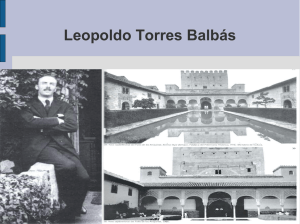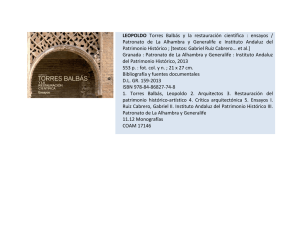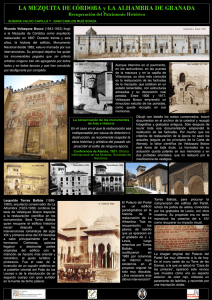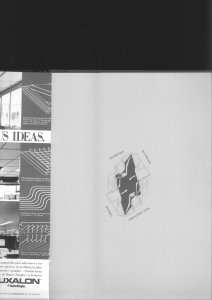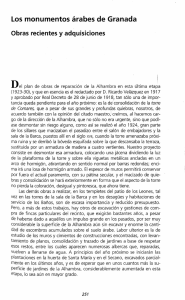Restorating al-Andalus - bauforschungonline.ch
Anuncio
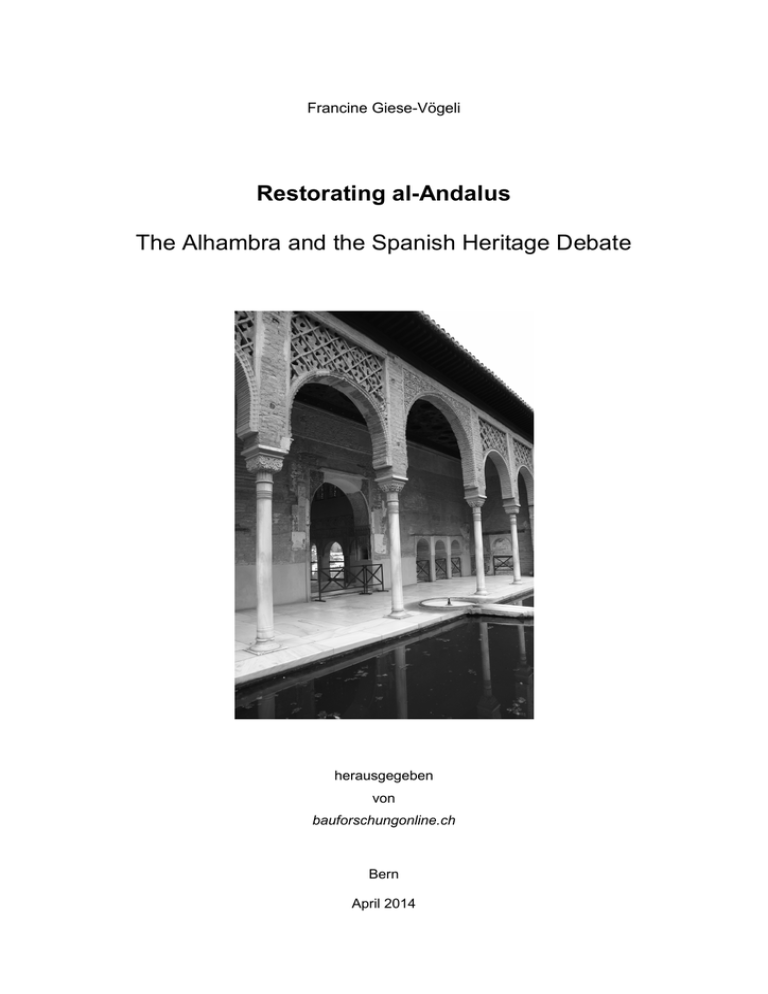
Francine Giese-Vögeli Restorating al-Andalus The Alhambra and the Spanish Heritage Debate herausgegeben von bauforschungonline.ch Bern April 2014 Restorating al-Andalus The Alhambra and the Spanish Heritage Debate Francine Giese-Vögeli Introduction In 1492 Granada, the last stronghold of Islamic power in Spain, was conquered by the Catholic monarchs Ferdinand and Isabella, converting the Alhambra to one of the main symbols of the Reconquista (1). Despite its ‘Christianisation’, the famous palace city of the Nasrids kept its image as a former place of oriental court life, intrigues and unfulfilled love. After being excluded from the traditional routes of the so-called ‘Grand Tour’, Spain and most of all Granada became the chosen destination of 19th century travellers (2). Immortalizing their impressions in books, paintings or contemporary architecture, they created a series of pictures of a long gone time, idealizing the ruinous palace buildings (3). In so doing, they created an ‘imaginary Alhambra’, which not only influenced the general perception of the monument but also played a decisive role in the controversial restorations of the 19th and early 20th century. As will be shown below, it was not until the arrival of the architect Leopoldo Torres Balbás in 1923 that the ideas of John Ruskin, Camillo Boito or Gustavo Giovannoni were determinant for the Alhambra. The 19th century and the creation of an ‘imaginary Alhambra’ In the spring of 1829, at a time, when al-Andalus and its Islamic remains were in the focus of travellers searching for the picturesque, a young American named 1 Washington Irving visited Granada in company of a member of the Russian Embassy at Madrid. Staying for three months, living in the Nasrid palaces, Irving recorded his impressions, observations und adventures in his famous Tales of the Alhambra, first published in 1832 (4). Explaining what the palace city of Granada ment to him and his contemporaries, he wrote: “To the traveller imbued with a feeling for the historical and poetical, so inseparably intertwined in the annals of romantic Spain, the Alhambra is a much an object of devotion as is the Caaba to all true Moslem.” (5) Washington Irving wasn’t the first visitor of the Alhambra and by far not the last. Many others went on a pilgrimage to the romantic Mecca located in southern Spain (6). Most interesting regarding to the above mentioned topic are the representations and descriptions of the different parts of the Alhambra by its 19th century visitors. While Alexandre de Laborde, James Canavah Murphy, Girault de Prangey or Jules Goury and Owen Jones considered the Alhambra as an object of study (7), recording its architecture following the then applied standards, many others used the Nasrid palaces as the chosen set of their romantic tales (8). By “clothing naked realities with the illusion of the memory and the imagination” (9), they became the elected spot for romantic reveries. That these “phantasmagoria[s] of the mind” (10) contrasted sharply with the actual reality of the monument was quite obvious. Executed mainly in mud, wood, plaster and more sporadicly brick and stone, the fragile decorations, the pisé-walls, the opulent ceilings and vaults felt in desolation shortly after being neglected. 2 The Rebirth of the Nasrid Palaces Because of the alarming state of conservation of the Alhambra, further damaged by the occupation of the site by French troops between 1810 and 1812, consolidation and restoration works inside the Nasrid palaces were accomplished long before the institutionalization of the protection of historical monuments by the Spanish Government and the creation of a supervising commission, the so-called Comisión de Monumentos in 1844 (11). As in the rest of Europe, the need for regulation and control became obvious, given the restorations executed during the 19th century in the Alhambra and elsewhere in Spain. Starting in 1828 and lasting until 1907, the Contreras family, José, Rafael and finally Mariano, considered the Alhambra almost as their own. Following the restoration ideology of Viollet-le-Duc, predominant in Spain right into the beginning of the 20th century, they recreated whole areas, mostly without any conclusive archaeological or documental evidence, giving rebirth to the ruinous palace buildings of the Nasrids (12) (Fig. 1). Being a subject of discussion in newspapers, periodicals and books of the time, the restorations executed by the Contreras in the Alhambra split the Spanish public in two antagonistic camps. The arguments of the one side in pro of the Contreras can best be illustrated by quoting Miguel Lafuente Alcantara: “Sería cosa digna de admirarse el patio de los Leones en su integridad: el brillo del pavimento, el primor de los templetes y galerías sustentados por jaspes blancos como la nieve; el adorno de las paredes esmaltadas de oro, plata y púrpura, y la transparencia del agua despeñada en la fuente de los Leones, ó saltando de las muchas tazas de alabastro repartidas en su recinto, presentarian 3 una de aquellas decoraciones maravillosas que nos pintan los cuentos fantásticos de las Mil y una noches.” (13) The other side, taking up an opposite position by condemning the restorations of the Contreras makes itself heard in the words of José Gimenez-Serrano: “Esta joya preciosa bien mereceria mejor conservacion y que manos impías y groseras no la destrozasen. Al santuario deben acercarse los profanos destocados y con veneracion: preféribles son las ruinas á prosáicas y disparatadas restauraciones: escitan las unas poéticos sentimientos y desprecio las otras.” (14) Leopoldo Torres Balbás and the “restauro scientifico" Unlike the rest of Europe, the conservation theories of John Ruskin (1819-1900) obtained broader acceptance in Spain only around 1915, along with related ideas of Italian architects like Camillo Boito (1836-1914) and Gustavo Giovannoni (18731947) (15). Together with Jeroni Martorell i Terrats (1876-1951) and Joseph Puig i Cadafalch (1867-1956), the Madrilenian architect Leopoldo Torres Balbás (18881960) became one of the leading figures of a new approach towards the conservation and maintenance of historical monuments in the early 20th century Spain (16). In 1923 Torres Balbás was appointed conservator of the Alhambra, replacing Modesto Cendoya, assigned in 1907 (17). Based on the Plan General de Conservación de la Alhambra, elaborated by the architect Ricardo Velázquez Bosco between 1915 and 1917 (18), Torres Balbás made the decisive step of bringing to 4 perfection some romantic and exotic scenery to the actual conservation of the building fabric (19). As a member of the Spanish delegation at the First International Congress of Architects and Technicians of Historic Monuments held in 1931 in Athens, Torres Balbás had the opportunity to present some examples of the works executed since 1923 in the Nasrid palaces, illustrating his new conservation policy. The main principles implemented by Torres Balbás, broke with the restoration practice predominant in the Alhambra until his arrival: “Les constructions anciennes ont été entièrement respectées, en accord avec les intérês archéologiques et artistiques; on s’est efforcé essentiellement de conserver et de réparer, ne recourant qu’en dernier ressort aux restaurations proprement dites; on s’est attaché à ce que les traveaux modernes ne fussent jamais une falsification, qu’ils pussent toujours se différencier nettement de la construction originale.” (20) In agreement with the general conclusions of the Athens Charter for the Restoration of Historic Monuments adopted at the just mentioned Conference of 1931 (21), the above quoted position of Torres Balbás had a considerable impact on the Spanish conservation law, passed on May 13th 1933 and effective until 1985 (22). The ideological turn undergone in the early 1930ies in Spain, showing the general acceptance of the so-called restauro scientifico, established by the above mentioned Camillo Boito (23), can best be observed in the Palacio del Partal, one of the main palaces of the Alhambra (Fig. 2). According to his diary-notes, published posthumous in the Cuadernos de la Alhambra, Torres Balbás began the restoration of the Partal in 1923 by repairing and 5 reinforcing its walls and piers as well as the wooden ceilings and roof constructions. To recover the original appearance of its portico-facade, subsequently walled up, Torres Balbás evaluated the available graphical, documental and archaeological evidence, which allowed its restitution (Fig. 3). But unlike his predecessors, Torres Balbás left the alterations visible and retained from doubtful reconstructions (24). Notwithstanding their positive response in Spain and abroad, the restorations of the Alhambra should not follow the new path for very long. At the outbreak of the Spanish civil war in 1936, distinguished architects like Torres Balbás were replaced because of their political orientation, and despite the above mentioned conservation law of 1933 a return to pro-restoration practices took place in the country, leaving its traces in the Alhambra as well (25), as can be seen at the just mentioned Partal palace, where Jesús Bermúdez Pareja replaced in 1965 the brick piers of the porticofacade by marble columns; a falsification, as we know today (Fig. 3). The Alhambra an the Spanish Heritage Debate Looking back to the thirteen years Torres Balbás presided the conservation department of the Alhambra, his theoretical and practical achievements are judged today as highly important for Spain and the Alhambra. Without him, the Nasrid palaces would most probably have been converted into the oriental Eden described by so many 19th century travellers, losing their authenticity or as Ruskin would have said, their glory (26), for the sake of a romantic vision far away from reality. 6 Bibliography Alvarez Lopera 1977a José Alvarez Lopera, “La Alhambra entre la conservación y la restauración (1905-1915)”, Cuadernos de Arte de la Universidad de Granada, 1977, vol. 29-31. Alvarez Lopera 1977b José Alvarez Lopera, “Una decisión polemica: el cese de Cendoya en 1923”, Cuadernos de la Alhambra, 1977, vol. 13, pp. 161-173. Avila Granados 2006 Jesús Avila Granados, Viajeros por Andalucía, Sevilla: Fundación José Manuel Lara, 2006. Boito 1885 Camillo Boito, “I nostri vecchi monumenti. Necessità di una legge per conservarli”, Nuova Antologia, 1885, vol. LXXXI, pp. 640-656 and vol. LXXXII, pp. 58-73. Boito 1886 Camillo Boito, “I nostri vecchi monumenti. Conservare o restaurare”, Nuova Antologia, 1886, vol. LXXXVII, pp. 480-506. Boito 1893 Camillo Boito, “I restauri in architettura. Dialogo primo. Restaurare e conservare”, Questioni pratiche di Belle Arti, Milano: Ulrico Hoepli, 1893, pp. 3-48. Casar Pinazo/Esteban Chaparía 2008 José Ignacio Casar Pinazo, Julián Esteban Chaparía (ed.), Bajo el signo de la victoria. La conservación del patrimonio durante el primer franquismo (1936-1958), Beniparell, Valencia: Pentagraf, 2008. Chateaubriand 1826 François Auguste René de Chateaubriand, Les aventures du dernier Abencerage, Paris, 1826. Conservation des Monuments 1933 La Conservacion des Monuments d’Art & d’Histoire, Paris: Office International des Musées, 1933. Esteban Chaparía 2002 Julián Esteban Chapapría, “El expediente número 1652/1940 de responsabilidades políticas: proceso de depuración a Leopoldo Torres Balbás”, Papeles del Partal, 2002, vol. 1, pp. 51-71. Esteban Chaparía 2012 Julián Esteban Chaparía, Leopoldo Torres Balbás. Un largo viaje con la Alhambra en el corazón, Beniparrell: Pentagraf, 2012. Galera Andreu 1992 Pedro Galera Andreu, La imagen rómantica de la Alhambra, Madrid: El Viso, 1992. García Cuetos et al. 2010 María del Pilar García Cuetos, María Esther Almarcha Núñez-Herrador, Ascensión Hernández Martínez (ed.), Restaurando la memoria. España e Italia ante la recuperación monumental de posguerra, Gijón: Ediciones Trea, 2010. 7 García Cuetos et al. 2012 María del Pilar García Cuetos, María Esther Almarcha Núñez-Herrador, Ascensión Hernández Martínez (ed.), Historia, restauración y reconstrucción monumental en la posguerra española, Madrid: Abada Editores, 2012. García Mercadal 1999 José García Mercadal, Viajes de Extranjeros por España y Portugal desde los tiempos más remotos hasta comienzos del siglo XX, 6 vols., Salamanca: Junta de Castilla y León, 1999. Garnica 2004 Antonio Garnica (ed.), Washington Irving en Andalucía, Sevilla: Fundación José Manuel Lara, 2004. Gimenez-Serrano 1846/1981 José Gimenez-Serrano, Manual del artista y del viajero en Granada, Reprint, Granada: Solinieve, 1846/1981. Girault de Prangey 1837 Philibert Joseph Girault de Prangey, Monuments Arabes et Moresques de Cordoue, Séville et Grenade, Paris: Veith et Hauser, 1837. Girault de Prangey 1842 Philibert Joseph Girault de Prangey, Choix d’ornements Moresques de l’Alhambra, Paris: A. Hauser, 1842. González-Varas 2006 Ignacio González-Varas, Conservación de Bienes Culturales. Teoría, historia, principios y normas, th 5 edition, Madrid: Cátedra, 2006. Goury/Jones 1842-1845 Jules Goury and Owen Jones, Plans, Elevations, Sections and Details from the Alhambra, 2 vols., London: Owen Jones, 1842-1845. Guichard 2000 Pierre Guichard, Al-Andalus 711-1492, France: Hachette, 2000. Hugo 1829 Victor Hugo, “Grenade”, Les orientales, Paris, 1829, XXXI. Irving 1832/2006 Washington Irving, Tales of the Alhambra, 2 nd edition, León: Everest, 1832/2006. Irving 2009 Washington Irving and the Alhambra (1859-2009), exhibition catalogue, Palace of Charles V, Alhambra, Granada, October 2009 to February 2010, Granada: Patronato de la Alhambra y Generalife und TF Editores, 2009. Koppelkamm 1987 Stefan Koppelkamm, „Die Faszination der Alhambra: »Wissenschaftlicher« Orientalismus“, Der imaginäre Orient. Exotische Bauten des achtzehnten und neunzehnten Jahrhunderts in Europa, Berlin: Ernst & Sohn, 1987, pp. 61-84. Laborde 1812 Alexandre de Laborde, Voyage pittoresque et historique de l’Espagne, vol. III, Paris: Pierre Didot l'Ainé, 1812. 8 Lafuente Alcantara 1849/1986 Miguel Lafuente Alcantara, El libro del viajero en Granada, Reprint, Granada: Donquijote, 1849/1986. Martinez de Carvajal 1989 Angel Isac Martinez de Carvajal, “Torres Balbás y la restauración arquitectonica en España”, Cuadernos de la Alhambra, 1989, vol. 25, pp. 45-55. Muñoz Cosme 1991 Alfonso Muñoz Cosme, “Cuatro siglos de intervenciones en la Alhambra de Granada, 1492-1907”, Cuadernos de la Alhambra, 1991, vol. 27, pp. 151-189. Muñoz Cosme 2005 Alfonso Muñoz Cosme, La vida y la obra de Leopoldo Torres Balbás, Sevilla: Instituto Andaluz del Patrimonio Histórico, 2005. Murphy 1815 James Cavanah Murphy, The Arabian Antiquities of Spain, London: Cadell & Davies, 1815. Ordieres Díez 1995 Isabel Ordieres Díez, Historia de la restauración monumental en España (1835-1936), Madrid: Ministerio de Cultura, 1995. Rodríguez Domingo 1996 José Manuel Rodríguez Domingo, La restauración monumental de la Alhambra: De Real Sitio a Monumento Nacional (1827-1907), Memoria de licenciatura, Universidad de Granada, Dep. de Historia del Arte, 1996. Ruskin 1880/1989 John Ruskin, The Seven Lamps of Architecture, 2 nd edition, Reprint, New York: Dover Publications, 1880/1989. Seguí Perez 1986 José Seguí Perez, Plan especial de protección y reforma interior de la Alhambra y Alijares, Granada: Consejería de Obras Públicas y Transportes de la Junta de Andalucía and Consejería de Cultura de la Junta de Andalucía, 1986. Torres Balbás 1919 Leopoldo Torres Balbás, “Legislación, inventario gráfico y organización de los Monumentos Históricos y Artísticos de España”, VIII Congreso Nacional de Arquitectos, Zaragoza: La Editorial, 1919, pp. 5-39. Torres Balbás 1924 Leopoldo Torres Balbás, “A través de la Alhambra”, Boletín del Centro Artístico, 1924, pp. 10-17. Torres Balbás 1927 Leopoldo Torres Balbás, “La Alhambra y su conservación”, Arte Español, 1927, vol. VIII, No. 7, pp. 249-253. Torres Balbás 1933a Leopoldo Torres Balbás, “La reparación de los monumentos antiguos en España”, Arquitectura, 1933, No. 165, pp. 1-10. 9 Torres Balbás 1933b Leopoldo Torres Balbás, “La Restauracion des Monuments en Espagne”, La Conservacion des Monuments d’Art & d’Histoire, Paris: Office International des Musées, 1933, pp. 67-69. Torres Balbás 1951 Leopoldo Torres Balbás, “Los Reyes Católicos en la Alhambra”, Al-Andalus, 1951, vol. XVI, fasc. 1, pp. 185-205. Torres Balbás 1960 Leopoldo Torres Balbás, “En torno a la Alhambra”, Al-Andalus, 1960, vol. XXV, fasc. 1, pp. 203-219. Torres Balbás 1965 Leopoldo Torres Balbás, “Diario de obras en la Alhambra: 1923”, Cuadernos de la Alhambra, 1965, vol. 1, pp. 75-92. Torres Balbás 2013 Leopoldo Torres Balbás y la restauración científica. Ensayos, Granada und Sevilla: Patronato de la Alhambra y Generalife und Instituto Andaluz del Patrimonio Histórico, 2013. Uhde 1892 Constantin Uhde, Baudenkmäler in Spanien und Portugal, vol. 1, Berlin: Ernst Wasmuth, 1892. Vílchez Vílchez 1988 Carlos Vílchez Vílchez, La Alhambra de Leopoldo Torres Balbás. Obras de restauración y conservación. 1923-1936, Granada: Comares, 1988. Vílchez Vílchez 1990 Carlos Vílchez Vílchez, “El Plan General de conservación de la Alhambra de Ricardo Velázquez Bosco”, Cuadernos de la Alhambra, 1990, vol. 26, pp. 249-264. Vílchez Vílchez 1999 Carlos Vílchez Vílchez, Leopoldo Torres Balbás, Granada: Comares, 1999. Viñes 1999 Cristina Viñes, Granada en los libros de viaje, 2 nd edition, Granada: Miguel Sánchez, 1999. Notes (1) Guichard 2000, pp. 208-226. See further Torres Balbás 1951, pp. 185-205. (2) Viñes 1999, pp. 19-24. (3) Galera Andreu 1992. Koppelkamm 1987. Viñes 1999. (4) Garnica 2004. Irving 2009. (5) Irving 1832/2006, p. 33. (6) For further reading see Galera Andreu 1992. García Mercadal 1999. Viñes 1999. Avila Granados 2006. 10 (7) Laborde 1812. Murphy 1815. Girault de Prangey 1837. Girault de Prangey 1842. Goury/Jones 1842-1845. (8) For two early exponents see Chateaubriand 1826 and Hugo 1829. (9) Irving 1832/2006, p. 99. (10) Irving 1832/2006, p. 99. (11) Muñoz Cosme 1991. (12) Torres Balbás 1933a, pp. 4-5. Alvarez Lopera 1977a, pp. 25-43. Muñoz Cosme 1991. Ordieres Díez 1995, pp. 115-117. Rodríguez Domingo 1996. (13) Lafuente Alcantara 1849/1986, p. 161. English translation (F. Giese-Vögeli): „It had to be admirable to see the Court of Lions in his integrity: the brilliance of the floor, the excellence of the pavilions and galleries, supported by snow-white jasper; the decoration of the walls, embellished with gold, silver and purple and the translucency of the water, dripping in the fountain of the Lions or springing from the many alabaster basins, which are situated in its area, would present one of the marvellous decorations, which the fairy tales of Thousand and one Nights are painting.”. (14) Gimenez-Serrano 1846/1981, p. 129. English translation (F. Giese-Vögeli): „This precious jewel would well deserve a better conservation and that impious and rough hands would not destroy it. The sanctuary has to be approached bareheaded and with veneration: ruins are to be preferred to prosaic and absurd restorations: the ones excite poetic feelings, the others contempt.”. (15) Ordieres Díez 1995, p. 126. For more information on the impact of Camillo Boito and his conservation theories in Spain, see Martinez de Carvajal 1989, p. 49 and González-Varas 2006, pp. 298-306. (16) Torres Balbás 1919, pp. 5-39. Torres Balbás 1924, pp. 10-17. Torres Balbás 1927, pp. 249-253. Torres Balbás 1933a, pp. 1-10. Torres Balbás 1960, pp. 203-219. Alvarez Lopera 1977a. Seguí Perez 1986, pp. 298-302. Vílchez Vílchez 1988. Martinez de Carvajal 1989, pp. 45-55. Ordieres Díez 1995, pp. 174-178. Torres Balbás 2013. For biographical data on Torres Balbás see Vílchez Vílchez 1999. Muñoz Cosme 2005. Esteban Chaparía 2012. (17) The substitution of Modesto Cendoya by Torres Balbás was most polemical, as has been shown by José Alvarez Lopera in 1977, see Alvarez Lopera 1977b. (18) Vílchez Vílchez 1990, pp. 249-264. 11 (19) Muñoz Cosme 1991, p. 151. (20) Torres Balbás 1933b, p. 69. (21) Conservacion des Monuments 1933, pp. 448-478. (22) Ordieres Díez 1995, pp. 36-41. González-Varas 2006, pp. 513-516. (23) Boito 1885. Boito 1886. Boito 1893. (24) Torres Balbás 1965 pp. 84-86. (25) Ordieres Díez 1995, p. 157. Esteban Chapapría 2002. González-Varas 2006, p. 316. For further reading see Casar Pinazo/Esteban Chaparía 2008. García Cuetos et al. 2010. García Cuetos et al. 2012. (26) In The Seven Lamps of Architecture John Ruskin describes the glory of a building as follows: “For, indeed, the greatest glory of a building in not in its stones, nor in its gold. Its glory is in its Age, and in that deep sense of voicefulness, of stern watching, of mysterious sympathy, nay, even of approval or condemnation, which we feel in walls that have long been washed by the passing waves of humaity. It is in their lasting witness against men, in their quiet contrast with the transitional character of all things, in the strength which, through the lapse of seasons and times, and the decline and birth of dynasties, and the changing of the face of the earth, and of the limits of the sea, maintains its sculptured shapeliness for a time insuperable, connects forgotten and following ages with each other, and half constitutes the identity, as it concentrates the sympathy, of nations: it is in that golden stain of time, that we are to look for the real light, and colour, and preciousness of architecture;”, see Ruskin 1880/1989, pp. 186-187. 12 Illustrations 1. Alhambra, Lions Court after the restoration of Rafael Contreras and Juan Pugnaire. 2. Alhambra, Partal palace before the restoration of Torres Balbás. 13 3. Alhambra, Partal palace after the restoration of Torres Balbás. 4. Alhambra, Partal palace after the restoration of Jesús Bermúdez Pareja. Illustration Credits: Fig. 1: Uhde 1892, Pl. 10. Fig. 2: Conservation des Monuments 1933, Pl. I-1. Fig. 3: Conservation des Monuments 1933, Pl. I-2. Fig. 4: F. Giese-Vögeli, June 2012. 14
